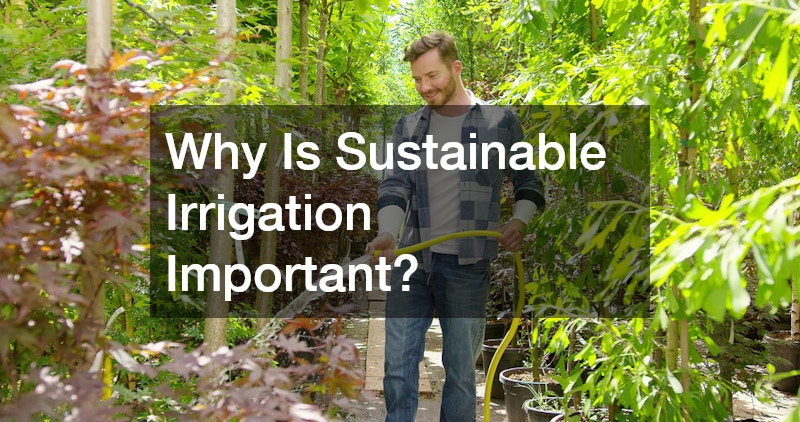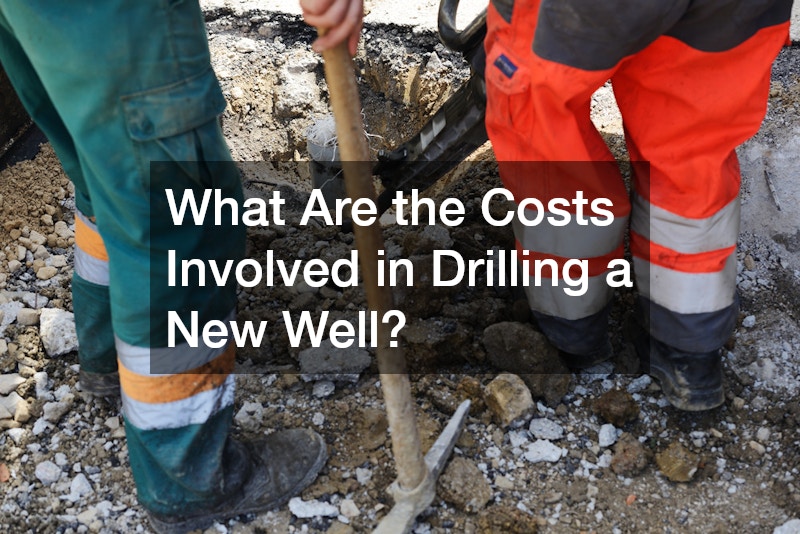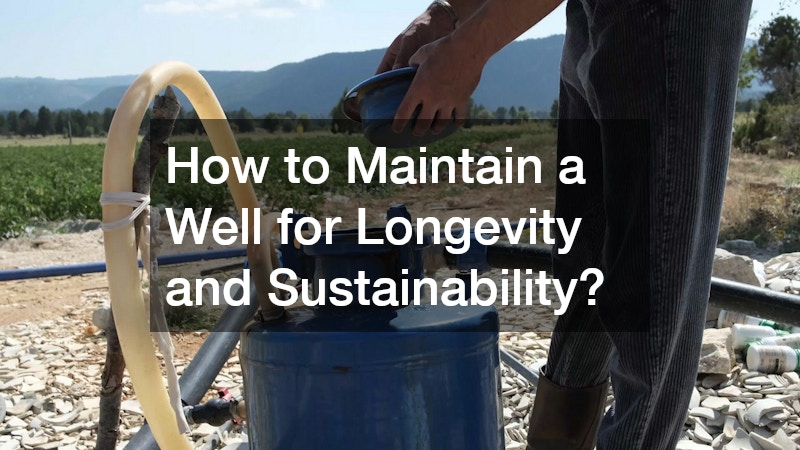How a New Well Can Make Your Irrigation More Sustainable
Water is one of the most precious resources on earth, and nowhere is that more apparent than in our own backyards, farms, and gardens. As climate patterns shift and droughts become more frequent, the need for sustainable irrigation practices has never been greater. Homeowners, farmers, and businesses alike are seeking smarter ways to water landscapes while conserving resources and preserving the environment. Among the solutions gaining traction is the installation of a new well.
A new well can provide a reliable, independent water source that reduces dependency on municipal systems and treated water supplies. When paired with modern technology and responsible management, a new well becomes not just a practical choice but also an eco-friendly investment in your land’s future. Beyond just helping with irrigation, a well can support native plants, local tree nurseries, and even erosion control blankets by ensuring consistent moisture without wasting treated water.
This article explores how a new well contributes to sustainable irrigation, diving into its environmental and economic benefits, the technology that makes it efficient, and the steps you need to take to make sure your well is environmentally responsible. Let’s dig into how a new well can be the heart of your sustainable landscaping strategy.
Why Is Sustainable Irrigation Important?

Environmental Impact
Sustainable irrigation minimizes harm to natural ecosystems. Overdrawing from surface water, or using chemically treated municipal water on plants, can degrade local habitats. A new well taps into underground aquifers, allowing property owners to reduce their environmental footprint while still supporting robust landscapes. Whether you’re growing a vegetable garden or maintaining ornamental natural stones and pathways, a new well helps keep things green in more ways than one.
Economic Benefits
Relying on a municipal water supply for irrigation can get expensive—especially during dry seasons when rates spike. A new well represents a one-time investment that can save you money for decades. By combining it with erosion control blankets, native plants from local tree nurseries, and smart irrigation systems, you maximize value while lowering long-term costs.
Water Conservation
A new well allows you to target water where it’s needed most, avoiding waste. Many modern landscaping services recommend wells because they can be combined with precision irrigation methods that conserve water while maintaining healthy plants and trees. Your local tree removal service may also appreciate a property that’s responsibly irrigated, reducing the chance of disease in your trees.
What Is the Role of a Well in Irrigation?
Water Source Management
A well provides control over your water source. Unlike municipal water that can be rationed or limited, a new well ensures a steady supply, tailored to your property’s needs. Many tree removal companies and garden plant nurseries recommend wells because they keep the soil moist for longer, which is critical for young plants and trees.
Consistent Water Supply
Seasonal droughts and restrictions can wreak havoc on landscaping projects. A new well provides consistency and independence, even when city water becomes unreliable or expensive. Local tree nurseries often rely on their own wells to ensure their plants thrive year-round.
Impact on Crop Yield
For those growing crops, fruits, or extensive gardens, a reliable water supply directly impacts yield. Irrigation contractors often suggest installing a new well to maintain optimum soil moisture, which can be the difference between a bountiful harvest and a disappointing season.
How Do New Wells Improve Water Efficiency?
Modern Drilling Techniques
Today’s wells are not what they used to be. With modern drilling equipment, a new well can be installed faster and with less disruption to the land. This means less soil erosion and more efficient water extraction. Landscaping services often work alongside drilling teams to ensure the well complements the overall property design.
Advanced Pump Technology
Pumps have come a long way. Energy-efficient models reduce electricity use while providing reliable pressure. Some tree removal companies now use water from wells to keep soil moist around root zones when removing or transplanting trees, minimizing stress on surrounding plants.
Monitoring and Automation
Pairing a new well with smart sensors allows you to automate your irrigation, conserving water while maintaining lush landscapes. An irrigation contractor can set up a system that draws just the right amount of water from your well based on soil moisture levels, weather forecasts, and plant needs.
What Are the Costs Involved in Drilling a New Well?

Initial Investment
Drilling a new well does require an upfront cost, which varies depending on depth, location, and equipment. Working with experienced professionals, like an irrigation contractor or arborist, ensures the investment is done right and maximizes return.
Maintenance Expenses
Ongoing maintenance is essential to keep the well efficient and compliant with local regulations. Simple tasks like testing water quality and checking pump performance will prevent bigger issues down the road. Tree removal companies and landscaping services that use wells for large-scale irrigation often schedule regular inspections.
Long-term Financial Savings
Over time, a new well can pay for itself. When combined with erosion control blankets, efficient pumps, and drought-tolerant plants from garden plant nurseries, the cost savings on water bills and municipal fees can be significant.
Are There Environmental Regulations for New Wells?
Local and Federal Guidelines
Local and federal laws govern where and how wells can be drilled, often varying by region. Before breaking ground, consult with an irrigation contractor or arborist familiar with these rules. They can help you navigate the process while minimizing environmental impact and ensuring your well is placed responsibly within the landscape.
Permits and Approvals
Permits are usually required to drill a new well, ensuring it meets environmental standards and doesn’t harm nearby water sources or ecosystems. Some areas even require input from a local tree removal service or landscaping professional if the drilling could impact protected trees, sensitive soil areas, or habitats for native wildlife.
Compliance and Monitoring
Regular monitoring and reporting may also be necessary, particularly if the new well draws significant water volumes or is located near conservation zones. Following these rules keeps your well compliant, environmentally sound, and a sustainable part of your long-term landscaping plan.
How Can a New Well Affect Local Ecosystems?
Impact on Aquifers
Overdrawing from an aquifer can deplete water levels and harm ecosystems. That’s why it’s important to consult professionals when drilling a new well. An arborist or landscaping service can recommend strategies that reduce the impact on the local environment.
Mitigating Negative Effects
Pairing your new well with techniques like mulching, using erosion control blankets, and planting drought-resistant species from local tree nurseries can help offset water usage and keep the ecosystem balanced.
Enhancing Biodiversity
A thoughtfully managed well can actually enhance biodiversity. Well-irrigated land supports native plants and wildlife while minimizing stress on the environment. Local tree nurseries and garden plant nurseries often use wells to create lush, sustainable habitats.
What Technologies Enhance Sustainable Well Usage?
Smart Sensors and IoT
Modern technology lets you monitor your new well remotely. Smart sensors track water levels, flow rates, and quality in real time, ensuring you’re not overusing resources. An irrigation contractor can help integrate these tools into your system.
Energy-efficient Pumps
Today’s pumps consume less energy and deliver better performance. Using energy-efficient equipment alongside natural stones and drought-resistant plants makes your entire landscape more sustainable.
Water Quality Monitoring
Regular testing ensures the water from your new well is safe and suitable for plants, crops, and possibly even drinking. Many landscaping services offer maintenance plans that include water testing and pump servicing.
How to Select Locations for Drilling a New Well?
Geological Surveys
Selecting the right spot for a new well is one of the most critical steps to ensure a sustainable and reliable water source. Geological surveys play a major role by examining soil conditions, underground rock formations, and water table levels. Without this knowledge, you risk drilling in an area where water is scarce, contaminated, or too deep to access economically. An arborist may also help evaluate how nearby tree roots and ecosystems could be impacted by drilling.
Hydrogeological Assessments
Hydrogeological assessments further refine the choice, predicting the yield of the well and ensuring it won’t damage surrounding aquifers or wildlife habitats. Collaborating with irrigation contractors and landscaping services during this process ensures that your well supports both your property’s needs and the local environment.
Proximity to Irrigation Fields
Proximity to irrigation fields and gardens is also important. Placing your well closer to landscaped areas, native plants from garden plant nurseries, and natural stones can reduce the energy and materials required for piping and pumping water. Planning your new well’s location with the help of professionals—including tree removal companies if necessary—helps protect trees, prevent damage to existing landscaping, and improve water efficiency for your entire property.
What Are Alternative Water Sources for Irrigation?
Rainwater Harvesting
While a new well provides a reliable, sustainable supply, it’s wise to consider alternative water sources to further minimize your environmental impact. Rainwater harvesting is a cost-effective and environmentally friendly method of collecting water for irrigation. Landscaping services and local tree nurseries often recommend installing rain barrels or larger cisterns to capture roof runoff. This water can complement your new well, especially during rainy seasons, and reduce the draw from underground aquifers.
Surface Water Utilization
Surface water utilization is another option, especially if your property already features a stream, pond, or lake. Combining surface water with a new well gives you flexibility during droughts while keeping your landscape—whether it’s full of trees, erosion control blankets, or ornamental natural stones—healthy and green.
Recycled and Reclaimed Water
Some properties also make use of recycled or reclaimed water systems, which treat greywater for safe use in irrigation. Local tree removal services and garden plant nurseries sometimes design irrigation setups that mix reclaimed water with well water, ensuring optimal water use while protecting sensitive plants and maintaining sustainable landscapes.
How to Maintain a Well for Longevity and Sustainability?

Routine Inspections
Maintaining your new well properly is essential to protect your investment and the environment. Routine inspections, conducted by an irrigation contractor, arborist, or specialized technician, help identify potential problems before they escalate. These professionals check pump performance, water quality, and structural integrity, ensuring your well continues to supply clean water for landscaping, natural stones, and garden plant nurseries.
Cleaning and Repairs
Regular cleaning and timely repairs keep the system efficient and prevent contamination. Over time, sediment, bacteria, and even invasive tree roots can interfere with water flow and quality. Many landscaping services work with well professionals during seasonal maintenance to safeguard the health of nearby trees and shrubs.
Modernization and Upgrades
Modernization and upgrades also play a role in longevity. As technology improves, upgrading your pumps, pipes, and sensors keeps your new well efficient and eco-friendly. Some tree removal companies suggest modernizing adjacent irrigation lines at the same time to better support transplanted trees and newly landscaped areas, ensuring your entire property stays lush and sustainable for years to come.
Conclusion
A new well is more than just a water source—it’s a cornerstone of sustainable irrigation. By providing an independent, reliable supply, it helps homeowners, farmers, and businesses reduce their reliance on municipal water while lowering costs and conserving resources. When combined with erosion control blankets, native plants from garden plant nurseries, and smart irrigation systems installed by an irrigation contractor, a new well creates a truly eco-friendly landscape.
Of course, installing and maintaining a new well requires careful planning. You’ll need to navigate regulations, choose the right location, and work with experienced professionals such as arborists, local tree removal services, and landscaping companies. Choosing sustainable practices—like pairing your well with energy-efficient pumps, smart sensors, and natural stones—can minimize environmental impact and even enhance biodiversity.
In the end, a new well is a powerful step toward a greener, healthier future for your property and the planet. Whether you’re maintaining an orchard, designing a backyard oasis, or managing large-scale landscaping services, investing in a new well ensures you’re watering wisely. By taking the time to plan, monitor, and maintain your well, you’ll enjoy lush, vibrant landscapes that respect the delicate balance of nature.
